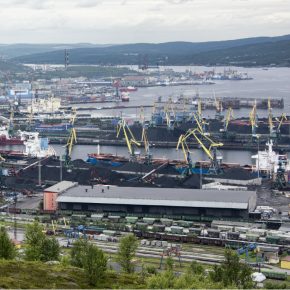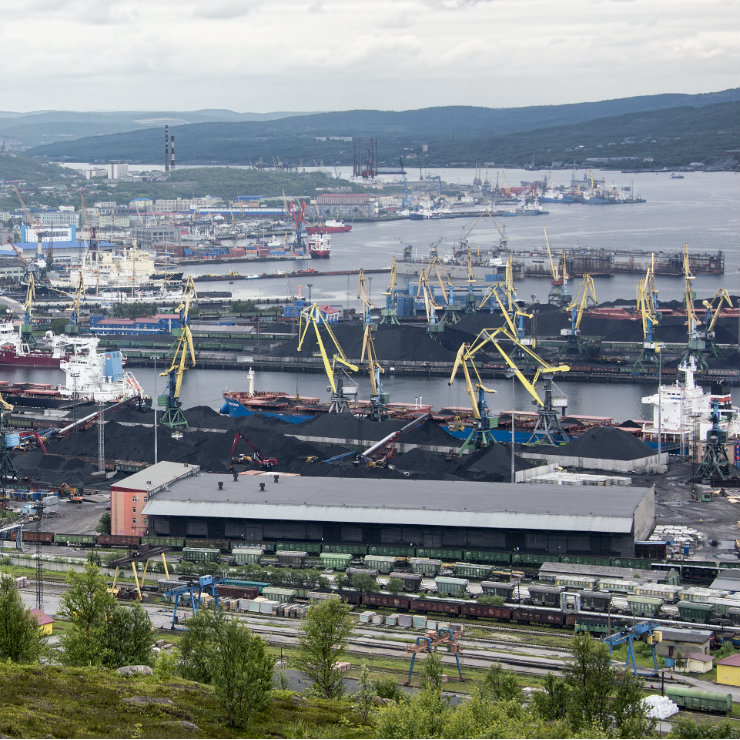Tydzień w gospodarce
Category: Trendy gospodarcze

Port of Murmansk, Russia (Christopher Michel, CC BY)
One of the key port facilities in the Russian Arctic, the port of Murmansk, saw an increase of cargo volume by 60,1 per cent y/y, according to the Russian Association of Commercial See Ports.
The amount of cargo shipped along what some call “the Russian alternative to the Suez Canal” has been growing steadily since 2013, with the last years in particular, seeing a surge in freight tonnage. For example, in 2015, the volume of cargo transported along the route surpassed the previous year’s volume by 36 per cent, only to grow by another 33 per cent the following year.
However significant this recent increase might appear to be, it is still far below the alternative route’s full potential. The Northeast Passage (NP) has been in use since the early days of the Soviet Union, originally intended to be used as a blockade-free exit route during World War I. Its utilization peaked in the late 1980s, when the annual cargo volume reached 6,5 million tons, only to see a significant slowdown in 1990s.
The Soviet record has already been beaten last year, which saw the total amount of 7,3 million tons of cargo shipped along the Northeast Passage. The last year’s number still represents a mere fraction of what the full potential of the NP might be. According to the head of Atomflot, Russian company and service base that maintains the world’s only fleet of nuclear-powered icebreakers, Vyacheslav Ruksha, the figure will eventually increase tenfold. The plan is to reach 40 million tons of cargo by 2024 and double that number by 2029.
In order to reach NP’s full potential, Russia has been allocating large amounts of financial resources on the development of its nuclear-powered icebreaker fleet. According to some estimates, 8 nuclear-powered icebreakers will be required to reach the goal set for 2029.
Currently, Murmansk-based, state-owned Atomflot, which is tasked with maintenance of Russia’s fleet of nuclear-powered icebreakers, operates 2 nuclear icebreakers with twin-nuclear power plants, and two icebreakers with single-reactor nuclear facilities. These icebreakers are used to ensure the security of commercial ships traversing the Northeast Passage.
In addition to the icebreakers already in operation, a total of 14 diesel, as well as nuclear-powered icebreakers are currently in construction, all of them are being constructed at shipyards in the Saint Petersburg area in the western part of the country.
Atomflot’s Arctic ambitions go far beyond just servicing Russia’s Arctic fleet. Atomflot’s parent company, Rosatom, drafted a bill that would grant it a full control over infrastructure and navigation along the Northeast Passage. This would basically give the Russian state the exclusive right to manage nearly all state affairs related to the Arctic, leading to a consolidation of the country’s Arctic policy.
The Russian government plans to build a unified transport system of the Arctic that would be used as a sort of a national maritime super highway, connecting several different ports along the Northeast Passage to a system of railroads and rivers in the northern parts of Russia. Improved infrastructure would bring the periphery closer to the center, allowing it to benefit from the economic interaction.
Apart from investing in the new generation of icebreakers, the Russian government has pledged to modernize existing Arctic ports and build new ones. One Russian Arctic region that is of particular interest to Moscow, and many other international investors for that matter, is the Yamal region, which harbors vast reserves of oil and natural gas. There are currently over 200 gas and oil fields in Yamal. Moreover, the region boasts proven hydrocarbon reserves of 44.5 trillion cubic meters of gas and nearly 5 billion tons of oil. This Russian region is home to the Yamal LNG project – a construction of a liquefied natural gas (LNG) plant with an output capacity of around 16.5 million tons per year.
The debate about the potential replacement of the conventional Suez or Panama Canal routes for international shipping between Atlantic and Pacific regions has been on-going for some time. The Northern Sea Route shortens the transport distance from northern Europe to northeast Asia and northwest North America by up to 50 per cent compared to southern routes through Suez or Panama Canal. By extension, it is assumed that the increasing traversability of the Arctic route will naturally lead international freight companies, eager to push down expenditures, to reconsider their shipping lanes choices.
The seemingly irrevocable Arctic sea ice retreat during the last couple of decades has already gravely impacted the Arctic marine transport systems and shelf exploration, and a considerable amount of studies seem to support the claim that this trend will continue in the years to come.
There are multiple variations of climate models, all projecting a slightly different view of what the future will hold. Nevertheless, most of these models are centered around the proposition that the 21st century will see further decrease of ice cover. This won’t immediately lead to the full availability of the Northern Sea Route (NSR) for commercial ships, but rather to prolonged open water conditions.
For example, in his recent paper Vyacheslav Khon, the Institute of Geosciences at Kiel University, calculated accessibility along the whole route for each day of the year. According to the models he selected for his study, the NSR transit navigation period will grow to (3,5 to 6,5 months per year), but only by the end of this century.
Moreover, even if the Arctic ice continues to melt to a considerable degree, there will still be several risks that could prevent many international freight companies from abandoning the Suez option. Multiple studies of the Arctic warn about high risks due to waves and accompanying storm surges and coastal erosions. Most of these natural forces are expected to be particularly strong along the NSR.
In any case, all debates about the presumed threat that the Suez Canal Authority could potentially face by the alternative, northern passage are still rather premature. The numbers speak for themselves. In 2016, 819 million tons of cargo was transported through the Suez Canal. The corresponding figure for the NSR was 7,3 million tons, a less than 1 per cent. In other words, even if the use of the NSR continues to skyrocket in the years to come, it won’t be able to challenge the Suez Canal’s position any time soon.
Filip Brokeš is an analyst and a journalist specializing in international relations.
The article was first published by bne IntelliNews

